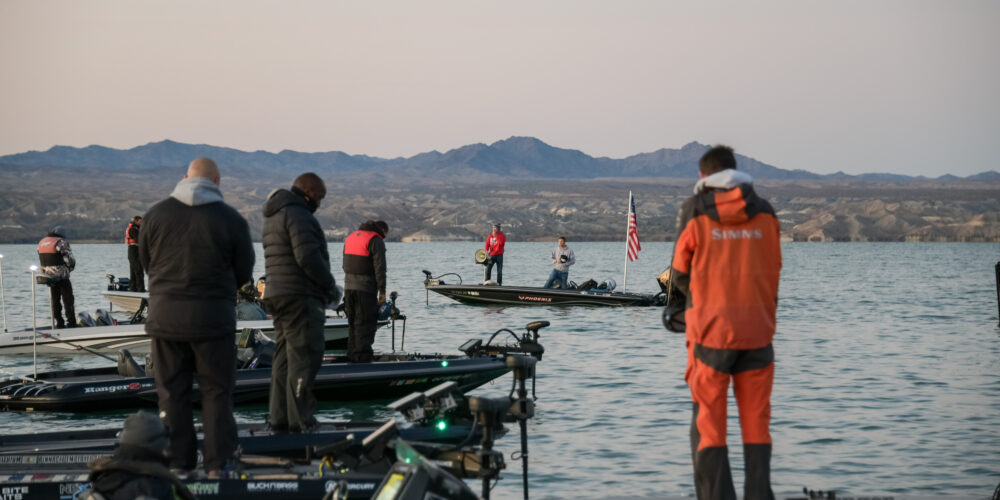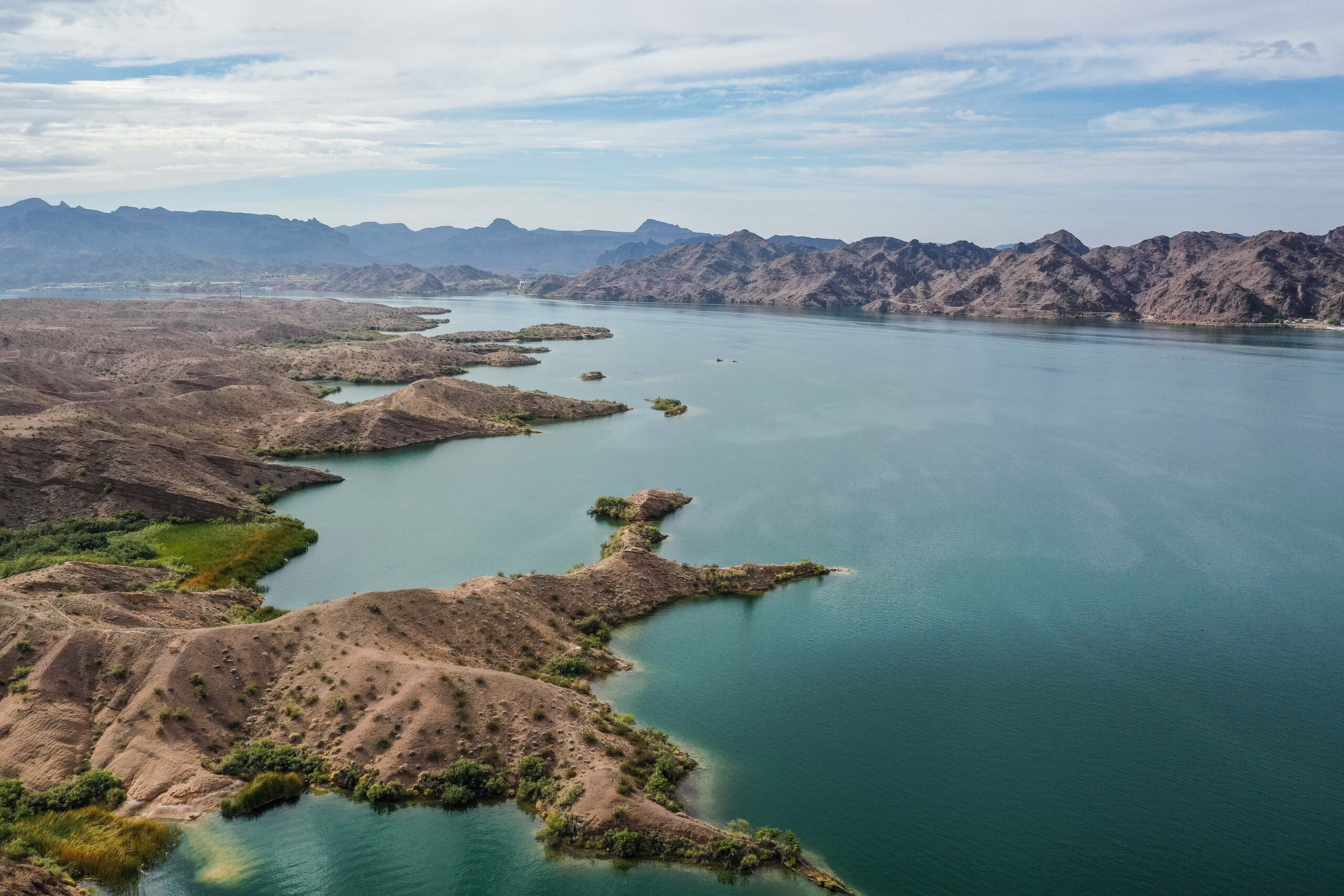Toyota Series Western Division season kicks off on Lake Havasu

LAKE HAVASU CITY, Ariz. – The season opener of the Western Division of the Toyota Series Presented by Phoenix Boats is underway on Lake Havasu.
The Western Division Presented by Tackle Warehouse has historically included this sprawling impoundment of the Colorado River in the rotation of lakes to kick off the season, but it’s been five years since a Toyota Series tournament was held this early on Havasu (the past two were March affairs). The difference of a month can often mean a stubborn winter bite instead of a wide-open spawn event.
Presented by Psycho Tuna, this week’s tournament sets up to be a classic desert showdown, with quality bags at the top and many more anglers scratching for each keeper bass in what can be one of the most challenging times of year to catch a bass in the Southwest.

About the fishery
Havasu is a typical Western desert fishery, with beautiful scenery, clear water and abundant structure (primarily natural rock). There’s also a good population of various vegetation and an abundance of artificial cover, all of which has the potential to hold quality bass.
The riverine fishery formed by the Colorado River features distinct sections that include the main lake and the many miles of fishable river and backwaters in the Colorado proper. The lake covers 19,300 acres and 26.3 miles, but there’s much more to explore.
Anglers fishing in the main lake can expect a variety of rock structure, pockets and coves lined with tules and an abundance of artificial structures that have been added for the past three decades by the Bureau of Land Management (BLM) and Lake Havasu Fisheries Improvement Program (LHFIP). The continuous addition of these reefs, cages and other structures turned Havasu from a tough lake to a great fishery capable of kicking out big largemouth and smallmouth bass. The habitat is scattered throughout the lake and fish will be caught fishing around them this week.
In the river, anglers will search for both largemouth and smallmouth in the main river current and the many tule-lined backwater areas. Both the river and lake offer the chance for tournament-winning bags, but the lake often wins out as it tends to hold more of the bigger fish. However, the top anglers this week will likely spread throughout the tournament boundaries.

Current conditions
The Arizona winter has offered more pleasant weather than usual, but both largemouth and smallmouth are still firmly in a winter pattern, according to Bass Pro Tour angler Roy Hawk, who will compete this week on his home waters.
“This has been a pretty mild winter and it’s been nice until just recently,” Hawk confirmed. “The water temperature has dropped 5 degrees in the past week with the cold snap, but it’s supposed to warm up each tournament day. That should make the fishing better and better every day.”
As evidence of the difference one month can make in the winning weight, California’s Patrick Touey totaled 66 pounds, 7 ounces in the March 2022 Toyota Series event here to win by a landslide; in the 2018 Series held on Havasu in February, local Shaun Bailey needed only 49-5 to win. Bailey’s victory was the last February Havasu kickoff for the Western Division and will serve as a good comparison for this event.
Havasu is fishing well, according to some anglers in the field, but it may look a little different than years past because of the water level and clarity. While still very clear compared to most fisheries across the country, the lake is more stained than usual, according to Bass Pro Tour angler and Lake Havasu City, Arizona resident Dean Rojas, who’s also fishing the event.
“Usually, you can see down 10 or 15 feet, but it’s more like 3 or 4 feet visibility now,” Rojas said. “The lake cycles from time to time with dirtier water flowing in and we’ve had a lot of wind recently to stir it up even more. It gets clearer toward the dam, but overall it’s not as clean as it should be this time of year. In my experience, that makes the fishing hit or miss with some great days up shallow and some very tough fishing other days.”
The dropping water level is also something to watch.
“It’s been above the winter pool level most of the winter but is now slowly coming down,” Hawk said. “It’s dropped about a foot in the last week, which doesn’t seem like a lot, but it’s a big deal for getting into some of the backwaters in the river, and the river bite has been really good this winter with the off-colored water and higher water levels.”

Tactics at play
Many different tactics could win the event, according to Hawk.
“There are so many things that work on Havasu and guys can win it several different ways this time of year, from Ned rigs to Alabama rigs,” he said. “You’ll see, when this event is over and you read how guys caught ’em, there will be tons of different things that worked. Crankbaits, jigs, ChatterBaits, jerkbaits, drop-shot rigs, hair jigs or ‘flies,’ and single swimbaits should all come into play. It’s going to be all across the board.”
Critical factors
- The kickers: Lake Havasu isn’t known for big fish and is more regarded for numbers of solid 3- to 5-pound specimens. But the chance for a largemouth weighing 7 pounds or more is a real possibility and will boost an angler’s bag and could push someone over the edge for a win.
- Largemouth or smallmouth?: On a lake with healthy fish of both species, either can win the event. The smallmouth fishing is thought to be in a small down cycle, so it’s seemingly more logical to bet on largemouth. Still, expect many mixed bags this week, as the two bass species tend to live in many of the same places this time of year.

Dock talk
While the weather looks fabulous for early February, with sun, light winds, and highs approaching 70 degrees on the first two days of competition and topping out at 74 on the final day. Rojas says the nice weather may hinder the fishing.
“Those nice weather days can be some of the toughest fishing days in the winter,” he said. “The winds are supposed to be light and while it will be nice to be outside, you need some low pressure and wind to get the fish biting here.”
The winds shouldn’t be a factor during the event, but it wiped out a day of practice for just about everyone on Tuesday, with heavy winds rocking the lake. Most chose to stay in for the day, including veteran pro Kurt Dove who made the trek from Texas for the event.
“I didn’t go out because you can’t get anything done in that kind of wind,” Dove said. “Plus, the conditions will be completely different for the event with light winds. The bad news is that you need some wind to get a bite here right now, and when it’s slick calm, it gets tough. I think this event will take some finesse and slowing down to catch them.”
Predictions
There are quality fish in Havasu to eclipse 20 pounds a day and the tournament will likely produce a handful of bags hitting that mark. The key, according to Hawk, will be consistency.
“It’s going to take two great bags and a ‘survivor’ type day or three consistent bags between 16 and 18 pounds to win it,” he said. “The interesting thing about the format, with the Top 25 fishing the final day, means that someone has a real shot at making a big rally to win on the final day if they get one of those mega bags in the mid-20s. I wouldn’t be surprised to see someone jump from 12th or 15th place to win because the weather is lining up for better fishing each day.”
Rojas shares a similar prediction: “The average weight will be between 16 and 19 pounds a day,” he said. “If it’s less than that, it will be understandable, too. The lake doesn’t do well with fishing pressure in multi-day events.”
Dove believes 17 pounds a day will be the mark.
“I think that will be very good for the conditions,” he said. “The smallmouth are starting to make their way to prespawn areas, but largemouth are dead in the middle of a winter pattern. The guys who figure it out this week will have to adjust on the fly, and I expect those with local knowledge to shine.”